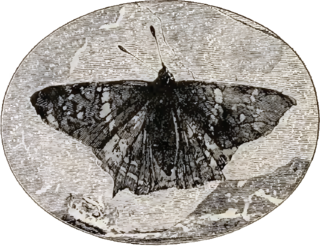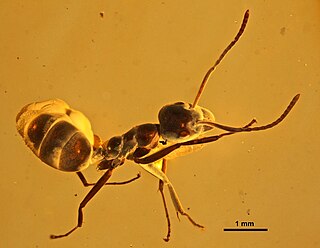Paleontology or palaeontology is the study of prehistoric life forms on Earth through the examination of plant and animal fossils. This includes the study of body fossils, tracks (ichnites), burrows, cast-off parts, fossilised feces (coprolites), palynomorphs and chemical residues. Because humans have encountered fossils for millennia, paleontology has a long history both before and after becoming formalized as a science. This article records significant discoveries and events related to paleontology that occurred or were published in the year 1936.

Aspidopleura is an extinct monotypic genus of parasitic wasp in the Eupelmidae subfamily Neanastatinae and at present, it contains the single species Aspidopleura baltica. The genus is solely known from the Early Eocene Baltic amber deposits in the Baltic Sea region of Europe.

Micropterigoidea is the superfamily of "mandibulate archaic moths", all placed in the single family Micropterigidae, containing currently about twenty living genera. They are considered the most primitive extant lineage of lepidoptera, and the sole superfamily in the suborder Zeugloptera. The name comes from the Greek for mikros, little and pterux, a wing. Unique among the Lepidoptera, these moths have chewing mouthparts rather than a proboscis, and are seen feeding, often in large aggregations, on the pollen of the flowers of many herbaceous plants, shrubs and trees. The fossil record of the group goes back to the middle-late Jurassic with the earliest known species being Auliepterix from the Karabastau Formation in Kazakhstan.

The Lepidoptera fossil record encompasses all butterflies and moths that lived before recorded history. The fossil record for Lepidoptera is lacking in comparison to other winged species, and tending not to be as common as some other insects in the habitats that are most conducive to fossilization, such as lakes and ponds, and their juvenile stage has only the head capsule as a hard part that might be preserved. Yet there are fossils, some preserved in amber and some in very fine sediments. Leaf mines are also seen in fossil leaves, although the interpretation of them is tricky. Putative fossil stem group representatives of Amphiesmenoptera are known from the Triassic.
Epiborkhausenites is an extinct genus of moth in the concealer moth family Oecophoridae and containing a single species Epiborkhausenites obscurotrimaculatus. The species is known only from Middle Eocene, Bartonian stage, Baltic amber deposits near the town of Palanga in Lithuania.

Plumalexius is a genus of wasps in the extinct monotypic family Plumalexiidae, containing two species: the type species Plumalexius rasnitsyni, known from the Late Cretaceous White Oaks Pit in Sayreville, New Jersey, and Plumalexius ohmkuhnlei, known from the Cretaceous Burmese amber.

Dryinus grimaldii is an extinct species of wasp in the dryinid genus Dryinus. The species is solely known from the early Miocene, Burdigalian stage, Dominican amber deposits on the island of Hispaniola.

Dryinus rasnitsyni is an extinct species of wasp in the dryinid genus Dryinus. The species is solely known from the early Miocene, Burdigalian stage, Dominican amber deposits on the island of Hispaniola.

Diochus electrus is an extinct species of rove beetle in genus Diochus, the only definitive fossil species in subfamily Staphylininae. The species is known only from the middle Eocene, Lutetian stage Baltic amber found in the Blaue Erde deposits, Baltic region, Northern Europe.

Deinodryinus? aptianus is an extinct species of Deinodryinus in the wasp family Dryinidae. The species is solely known from a Cretaceous fossil found in Mongolia.

Deinodryinus areolatus is an extinct species of Deinodryinus in the wasp family Dryinidae. The species is solely known from an Eocene fossil found in the Baltic region.

Deinodryinus velteni is an extinct species of Deinodryinus in the wasp family Dryinidae. The species is known solely from an Eocene fossil found in the Baltic region.

Arostropsis is an extinct genus of broad-nosed weevil in the beetle family Curculionidae known from an Upper Eocene fossil found in Europe. The genus contains a single described species, Arostropsis groehni.
Protostephanus is an extinct genus of crown wasp in the Hymenoptera family Stephanidae known from an Eocene fossil found in the United States of America. The genus contains a single described species, Protostephanus ashmeadi placed in the stephanid subfamily Stephaninae.
Pristomyrmex rasnitsyni is an extinct species of ant in the genus Pristomyrmex. The species is known from a single Late Eocene fossil which was found in Europe.

Usomyrma is an extinct genus of ant in the formicid subfamily Dolichoderinae. The genus contains a single described species, Usomyrma mirabilis, that is known from two Middle Eocene fossils which were found in Scandinavian amber in Denmark.

Yantaromyrmex is an extinct genus of ants first described in 2013. Members of this genus are in the subfamily Dolichoderinae of the family Formicidae, known from Middle Eocene to Early Oligocene fossils found in Europe. The genus currently contains five described species, Y. constrictus, Y. geinitzi, Y. intermedius, Y. mayrianum and Y. samlandicus. The first specimens were collected in 1868 and studied by Austrian entomologist Gustav Mayr, who originally placed the fossils in other ant genera until the fossils were reviewed and subsequently placed into their own genus. These ants are small, measuring from 4 to 6 mm in length and can be characterized by their trapezoidal shaped head-capsules and oval compound eyes that are located slightly to the rear of the capsules midpoint, with no known ocelli present.

Camelomecia is an extinct genus of stem-group ants not placed into any Formicidae subfamily and probably not into Formicidae itself. Fossils of the single known species, Camelomecia janovitzi, are known from the Middle Cretaceous of Asia. The genus is one of several ants described from Middle Cretaceous ambers of Myanmar.
Prosisyrina is an extinct genus of lacewing in the neuropteran family Sisyridae. The genus contains two described species, Prosisyrina sphinga and Prosisyrina sukachevae. Prosisyrina is known from a group of Late Cretaceous fossils which were found in Asia.
The Prussian Formation, previously known as the Amber Formation, is a geologic formation in Prussia, today mostly Kaliningrad Oblast that dates to the Eocene. It holds 90% of the world's amber supply and Baltic amber is found exclusively in the Prussian Formation.














